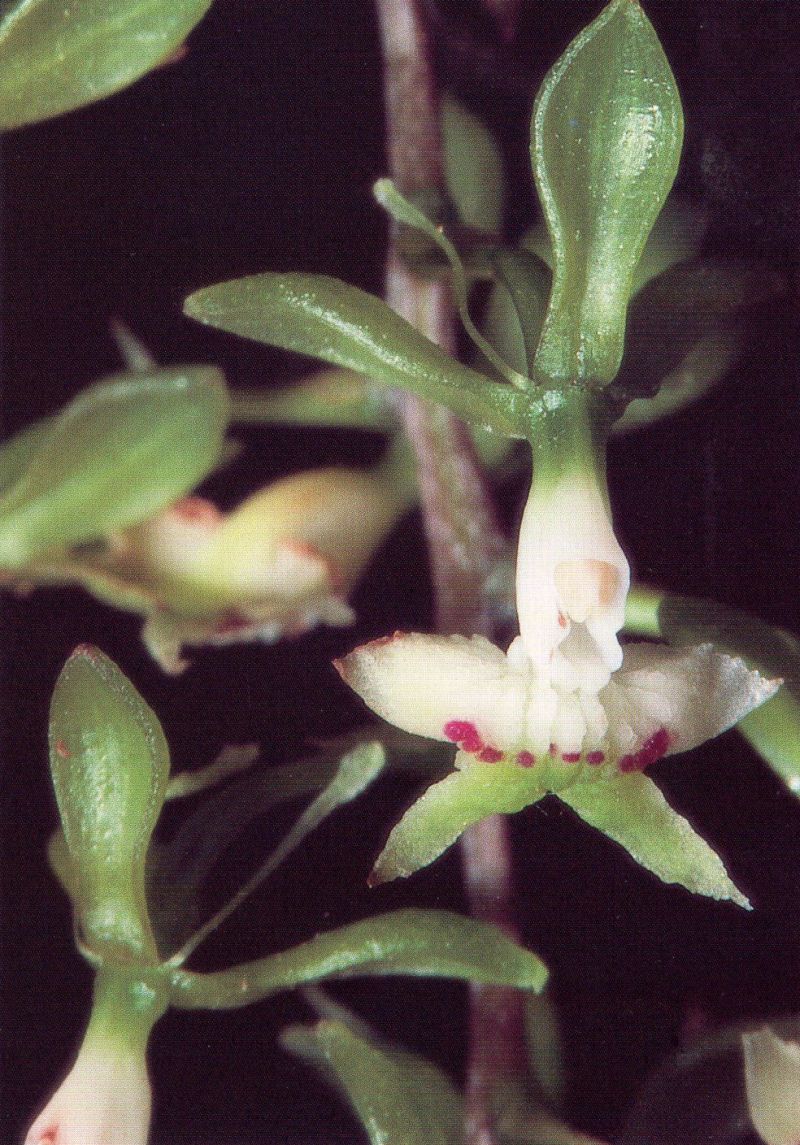

Epidendrum poeppigii Hágsater 1993 GROUP Pseudepidendrum SUBGROUP Paniculatum
TYPE Photo by © Alexander Hirtz
TYPE Drawing by © Jimenez and The AMO Herbaria Website




Common Name Poeppig’s Epidendrum [German Botanist & Explorer, He described over 4,000 plant species, investigated Incan ruins, and travelled the length of the Amazon River by raft and canoe; he was only the third European to make the entire 5,000 kilometer river journey - 1798 to 1868]
Flower Size .24” [6 mm]
Found in Ecuador and Peru on the eastern slope of the Andes at elevations of 800 to 2800 meters as a medium sized, cool to cold growing, caespitose epiphyte with simple, cane-like, slightly laterally compressed stems carrying 8 to 17, all along the apical half of the stem, erect, alternate, articulate, linear, acuminate, margin entire leaves that blooms in the spring on a terminal, somewhat paniculate, peduncle thin, 1.8 to 2.8” [4.5 to 7 cm] long, with a median, prominent, tubular, conduplicate bract, rachis with 1 to 4 short branches, each 1.6 to 6” [4 to 15 cm] long, 4 to 8” [10 to 20 cm] long overall, lax, successively 18 to 70 flowered inflorescence with much shorter than to as long as the ovary, narrowly triangular, acuminate, amplexicaul floral bracts and carrying resupinate green flowers with the lip and the apex of the column white, often with a ring of purple dots surrounding the disc.
"Epidendrum poeppigii belongs to the GROUP Pseudepidendrum is characterized by caespitose plants, cane-like stems, acute to acuminate leaves, apical inflorescence, lacking a spathaceous bract, the petals filiform and the lip usually 3-lobed, with 3 parallel fleshy keels, the apical lobe often bifurcate, and the pollinia “bird-wing” type and SUBGROUP Paniculatum which has bicolor flowers, generally green with the lip and apex of the column white, the disc sometimes marked with purple to red. The species is recognized by the small plants to 27.2" [68 cm] tall, thin stems and narrow, linear, long acuminate leaves; the successive flowers have .2" [5 mm] long, strongly reflexed sepals, the lip bicallose the column short and thick, .12" [3 mm] long. Epidendrum yungasense Rolfe has somewhat smaller plants ca. 16" [40 cm] tall, but the arching-pendent stems producing keikies, the leaves oblong-lanceolate, acute, simultaneous flowers and the column thin, .2 to .24" [5 to 6 mm] long. Epidendrum parviflorum Ruiz & Pavón has narrowly lanceolate, acute leaves, simultaneous flowers, spreading sepals, and the lip with a single callus and lateral and apical lobes rounded. Epidendrum patulipetalum Schltr. has small plants, (ca. 14" [35 cm] tall with linear-lanceolate, short leaves 2 to 2.8" [5 to 7 cm] long, partly spreading, sepals .2" [5 mm] long, and the lip partly embracing the column in natural position, bicallose, with prominent, thin calli." Hagsater 2010
Synonyms *Epidendrum gratiosum var. linearifolium 1898; Epidendrum paniculatum var. linearifolium (Cogn.) C.Schweinf. 1943
References W3 Tropicos, Kew Monocot list , IPNI ; *Orquideas Mexico City n.s., 13: 217 Hagsater 1993 drawing fide; Icones Orchidacearum 3 Plate 302 Hagsater 1999 see recogntion section; Icones Orchidacearum 3 Plate 347 Hagsater & Sanchez 1999 see recognition section; Icones Orchidacearum 4 Plate 471 Hagsater 2001 see recognition section; Icones Orchidacearum 4 plate 489 Hagsater & Sanchez 2010 see recognition section; Native Ecuadorian Orchids vol 2 Dodson 2001 photo fide; Icones Orchidacearum 13 Plate 1351 Hagsater & Dodson 2010 See Recognition section; Icones Orchidacearum 13 Plate 1373 Hagsater 2010 drawing fide; Icones Orchidacearum 13 Plate 1376 Hagsater & Dodson 2010 See Recognition section; Icones Orchidacearum 14 Plate 1472 Hagsater & Sanchez 2013 see recognition section; Icones Orchidacearum 14 Plate 1500 Hagsater & Sanchez 2013 see recognition section;
--------------------------------------------------------------------------------------------------------------------------